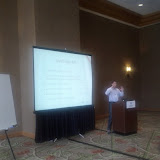Google also has that magic in web search or Google Earth. People look at it and just marvel. Old time GIS people are often frustrated by Google Earth, for instance, that they were doing maps and looking at satellite imagery, and if you just downloaded ArcView, and installed....and at that point they've lost the magic. No offense to ESRI products, they make some great stuff and for analysis there is nothing that beats them, but there isn't that easy, intuitive use to it that you find with Google's mapping products.
"Magic" often distracts people from the limitations of a device or site. Apple's products tie you into using iTunes for instance, and lock you into a platform. But people who love iPhones will line up to buy a new white version of the iPhone with little or no feature updates. Just because it's white. I'm not blaming them, it's an amazing job that Apple has done, creating that desire for a white iPhone you never knew that you had.
Netflix had the magic too, right? They have a really amazing recommendation engine, far better at surfacing movies and shows you wanted to see than any other similar site. Amazon, in my view, comes closest and their recommendations for movies and their interface are just terrible compared with Netflix. No one cared that Silverlight was being kept alive by Netflix, and we paid a nice premium to have it on a variety of devices. Ooops, can't view it in Australia, well there's always VPN right? The number of movies available, and free, and in the early days their ability to get you movies sometimes the day after you returned yours was truly magical.
Well, that's gone right? The hazard of magic, I think, is that when you lose it you really lose it. The vehemence that people reacted with was really incredible. There's been a lot of analysis of why this happened. There's an interesting piece on O'Reilly today about What publishers can learn from Netflix's problems. One of the singular moments in the whole thing was, however, when Netflix reassured us that DVDs from Qwikster would still be in the little red envelopes. The Oatmeal had a great comic on that. That was the moment the magic was gone, when people started screaming about that. The distraction, the attempt to get users to focus on things that don't add functionality, to create a mystique around a small aspect of the brand, had failed miserably.
I'm not sure United Airlines ever really had the magic. I fly a lot, and ended up on United flights frequently in the last year. They merged with Continental, and at the beginning of every flight in the last 6 months, they would put up a video with the president of United extolling the virtues of the merger. What were those virtues? Well, they were repainting planes. That's right. Continental planes were being repainted to United planes. By the third time I saw that video, which I couldn't get away from, I wanted to scream. Untied has an aging fleet of planes. Mostly uncomfortable, with TV screens placed above our heads in the ailes instead of in the seat backs, uncomfortable chairs, and food that is usually pretty bad and that you have to pay for. But they are a low cost airline that goes everywhere and has a great frequent flyer program with lots of partners. What I wanted to hear about was their plans for modernizing their fleet, or providing more leg room, or something like that. No magic at all.
OK, so what's the lesson of this? If you've got magic, you can get people excited by surface changes and get them to look away from your problems. If you lose that magic, or never had it, don't focus on the surface, focus on what people care the most about. In Netflix it was the price and then integrated app, DVDs and streaming together, working on fast, easy, and nice delivery of your product, video, to every platform. In United's case, focus on what's working for you and don't keep talking about appearance. People don't care about that as much as you think.


